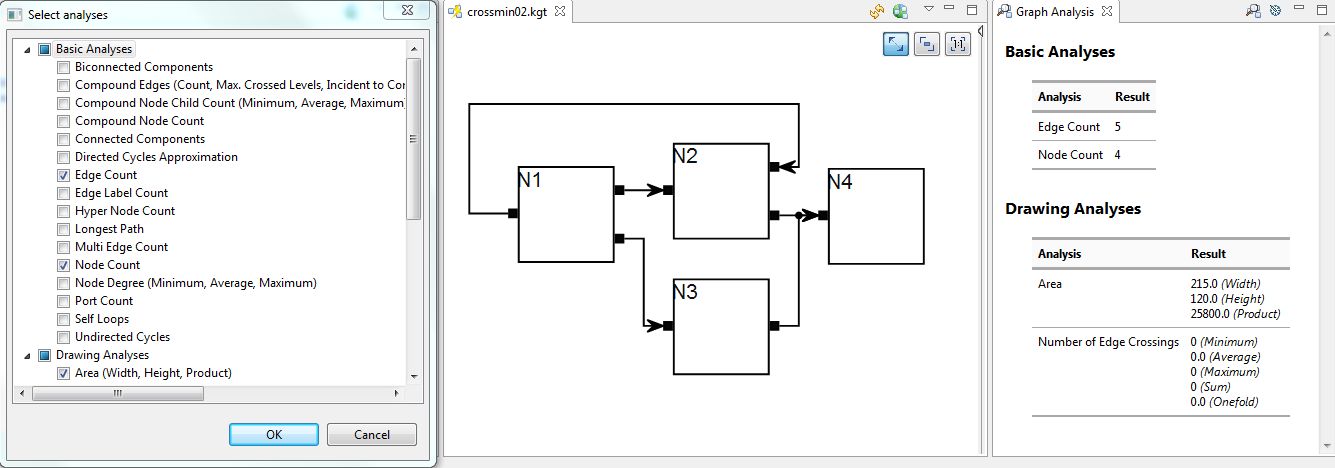Graph Analysis (GrAna)
Project Overview
Related Theses:
- Martin Rieß, A Graph Editor for Algorithm Engineering, September 2010 (pdf)
The Graph Analysis (GrAna) project allows to examine a broad variety of structural properties of a graph (node count, edge count, etc.) as well as properties of the final drawing (area, edge crossings, etc.). An analysis can either be performed on a single graph or batch-like on large collections of graphs, in which case the results are written to a file. We support a variety of input formats, namely every format our formats service knows about.
Single Graphs Within the Editor
Within Eclipse we provide a Graph Analysis view, which can be found via Eclipse's Windows->Show View->Others dialog.
In the top right corner of this view you can find two buttons, one of which performs the analysis on the lastly selected diagram. The other button allows you to configure the analysis, i.e. select specific analyses to perform. The following screenshot shows an example. On the very left it can be seen that the analysis was configured to list the node and edge count, the area, and the number of edge crossings. According to the results, the graph contains 4 nodes and 5 edges. This is correct because the hyperedge between nodes N2, N3, and N4 is structurally composed out of two edges and just drawn as a single edge. Counting hyperedges could be a different analysis. Moreover, the area is reported as 25800 and 0 edge crossings are present.

Batch Executions
A frequent use case is to analyze a large set of graphs with regards to some metric. For instance, you finished your awesome new algorithm to minimize the number of edge crossings in a graph and want to know how well it performs. The web offers large sets of graphs that already served as benchmarks in the past. GrAna allows batch analyses to be executed in two ways, textually and using an Eclipse Wizard.
Textually
We provide a concise DSL to specify the sets of graphs, the layout algorithm and options, and the analyses textually and store them in a .grana file. The DSL is based on Xtext, hence the editor comes with syntax highlighting, content assist, and formatting. An example specification can be found below.
You can specify a list of Jobs. A job is a self-contained unit of work. It specifies the previously mentioned data using the following keywords: resources, layoutoptions, analyses, and output. Layout options are specified by blocks that start with an arbitrary identifier followed by curly brackets. It is possible to specify multiple blocks of layout options. Each block results in a separate layout run allowing, for instance, to first execute a node placement algorithm and then an edge routing algorithm. For convenience it is possible to specify resources and output files globally at the beginning of the file and then use the ref keyword to reference them from a job.
Besides jobs, there are also RangeJobs and CompareJobs. A RangeJob can be used to analyze the effect of a specific layout option onto a specific metric. In the example below, the thoroughness layout option is registered using the rangeoption keyword. An integer range is specified resulting in all values between (inclusive) 1 and 50 being tested. While the analyses specified using the analyses keyword are only measured on the initial graph, the analysis specified using the rangeanalysis keyword will be measured for every tested value of the range layout option. Since analyses can be composed out of multiple components (e.g. the edge crossing analysis states the minimum, maximum, and average number of crossings per edge as well as the sum – four components), the component keyword tells GrAna which component to write to the output file. The CompareJob can apply two different layouts to a graph and compare the results (the graph is copied internally so the layouts do not influence each other). The two layouts are specified via two layout blocks as shown in the avg_distance example below. This kind of job can be used to analyze the effect of a layout on the individual nodes (e.g. the distance nodes are moved).
To execute GrAna based on a .grana file, right click the file and select Execute Analysis Batch ...
random "/Test/random/" filter ".*kgx"
north_graphs "file://D:/graphs/north" filter ".*graphml"
secret "/Test/secret/" filter ".*json"
globalOutputs
original_alg "/Test/results/original.csv"
awesome_alg "file://workspaces/eclps/Test/results/new.csv"
thoroughness "/Test/results/thorough.csv"
compare "/Test/results/compare.csv"
execute all
job original
layoutBeforeAnalysis
resources
ref random
ref north_graphs
ref secret
layoutoptions
klay {
de.cau.cs.kieler.algorithm: de.cau.cs.kieler.klay.layered
de.cau.cs.kieler.klay.layered.crossMin: LAYER_SWEEP
}
analyses
de.cau.cs.kieler.kiml.grana.nodeCount
de.cau.cs.kieler.kiml.grana.edgeCrossings
output ref original_alg
job my_awesome
layoutBeforeAnalysis
resources
ref random
ref north_graphs
ref secret
layoutoptions
klay {
de.cau.cs.kieler.algorithm: de.cau.cs.kieler.klay.layered
de.cau.cs.kieler.klay.layered.crossMin: LAYER_SWEEP
de.cau.cs.kieler.klay.layered.crossMin.awesome: true
}
analyses
de.cau.cs.kieler.kiml.grana.nodeCount
de.cau.cs.kieler.kiml.grana.edgeCrossings
output ref awesome_alg
rangejob thoroughness
resources
ref random
layoutoptions
klay {
de.cau.cs.kieler.algorithm: de.cau.cs.kieler.klay.layered
de.cau.cs.kieler.klay.layered.crossMin: LAYER_SWEEP
}
analyses
de.cau.cs.kieler.kiml.grana.nodeCount
rangeoption
de.cau.cs.kieler.klay.layered.thoroughness
intrange 1 to 50
// floatvalues 0.3, 0.4, 0.5
rangeanalysis
de.cau.cs.kieler.kiml.grana.edgeCrossings
component 3
output ref thoroughness
comparejob avg_distance
resources
ref random
layoutoptions
l1 {
algorithm: fixed
}
l2 {
algorithm: layered
}
analyses
de.cau.cs.kieler.grana.compare.averageDistance
output ref compare
Eclipse Wizard
Second, you can use an Eclipse Wizard to select one or more sets of graphs, specify and configure a layout algorithm, and select a set of analyses. Results are then written to a .csv file (or more precisely semicolon-separated-file).
The following series of screenshots illustrates the process of using the wizard.
Required Plugins
Core:
de.cau.cs.kieler.grana- Textual DSL:
- de.cau.cs.kieler.config.text
- de.cau.cs.kieler.config.text.ide
- de.cau.cs.kieler.config.text.ui
- de.cau.cs.kieler.grana.text
- de.cau.cs.kieler.grana.text.ide
- de.cau.cs.kieler.grana.text.ui